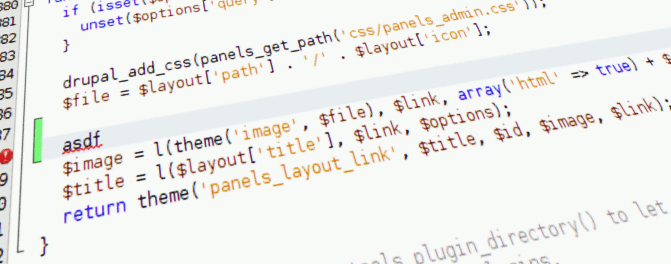Create a grungy poster in GIMP in 100 clicks or so

A qick intro. GIMP is an exceptional graphical tool, inmost cases, just as functional as Photoshop. With little exploration and creativity, it's possible to create almost any graphical design solely in GIMP. Internet is full of Photoshop tutorials, but there are not much tuts for GIMP. This isn't surprising since Photoshop is a commercial tool, which is the first choice of designers who want to pay and get what they pay for. I mean, time: usually it takes a little less time to create anything in Photoshop. In spite of that, for those who worked with GIMP and got used to it, it's clear that any Photoshop tutorial can be easily and with minimal side-effects translated to "GIMP patterns language". In this article I would like to demonstrate this and back my statement.
Developing with Open Source Software

Today, according to w3techs, more than two thirds of the web servers are based on Open Source Software (OSS). Also according to the same source, around 77% of websites are written with Open Source languages like PHP, Perl, Ruby, Python. This is a good reason to start being interested in OSS. Taking it a bit further, it seems that OSS is already ripe enough to provide plenty of tools which are enough to create any imaginable HTML based website. Here, I'm going to present some of the advantages and disadvantages of OSS for the Web Development and Design, and then show several empirically chosen apps.
But let's slow down a bit in order to examine a few obstacles that may keep you from stepping forward exploring.
asdf in web development and beyond
 You got it right. The asdf sequence as it may seem at the first glance is a very handy tool. When editing HTML, PHP or other type of code, frequently you need to pause your work and remember the current place in order to copy something from somewhere (maybe from the same big file) and then quickly go back and paste it right where you were focused before. Some people use bookmarks, others remember it. But remembering requires a minimal effort, when the "autopilot mode" is desired.
You got it right. The asdf sequence as it may seem at the first glance is a very handy tool. When editing HTML, PHP or other type of code, frequently you need to pause your work and remember the current place in order to copy something from somewhere (maybe from the same big file) and then quickly go back and paste it right where you were focused before. Some people use bookmarks, others remember it. But remembering requires a minimal effort, when the "autopilot mode" is desired. The quickest and most effective way to do that, is typing asdf. This does two good things to you:
- First, as you already guessed, it leaves a bookmark. So coming back is just as easy as pressing Ctrl-F and then stroking the magical asdf.
- Secondly, if you're editing a code which is compiled, then the compilation won't succeed, which means, you'll never forget to come back to this bookmark.
Finally, you can always use similar sequences like zxcv or qwer etc., to add more reminders as required.
No activity within 1440 seconds
 When developing websites with OSS, most likely that you're using the good eternal PHPMyAdmin for the DB interactions. One annoying thing about development, is that you rarely need the connections to the internal DB to be more secure than it would normally be on the server, or need just a minimal security as in case when you're working in a company which is protected by a good firewall. And why am I reminding this? Because during a work day you can return to PHPMyAdmin several [tens] of times and each time rediscover this annoying message which forces you to type again and again the username and the password, or at least, to click on the 'Go' button, or you know what? You know...
When developing websites with OSS, most likely that you're using the good eternal PHPMyAdmin for the DB interactions. One annoying thing about development, is that you rarely need the connections to the internal DB to be more secure than it would normally be on the server, or need just a minimal security as in case when you're working in a company which is protected by a good firewall. And why am I reminding this? Because during a work day you can return to PHPMyAdmin several [tens] of times and each time rediscover this annoying message which forces you to type again and again the username and the password, or at least, to click on the 'Go' button, or you know what? You know...
The cure?
Find your config.default.php with something similar to
locate config.default.php
Open the file, find the line which contains LoginCookieValidity and set the value to something like:
$cfg['LoginCookieValidity'] = 54000;
Drupal VS Ruby on Rails

When it's time to choose a language or framework or platform to develop a new website, you can't pass by Drupal or Ruby on Rails (RoR). Both are open source cutting edge 'mechanisms' for creating real beasts. Yet, only one must be chosen, and it's not a simple decision. Non open source platforms are left unnoticed, since they cannot be competent enough, not until now anyway. Other open source platforms like Django etc, are safely ignored as well (and pardon for that!) since they all try to mimic what was initially invented in Ruby On Rails. Wordpress and Joomla are left aside too, since the former is a very powerful tool, but very robust one and has somewhat limited functionalities, and the latter looses somewhat in configurability to Drupal.
But back to our beloved two. It would be simpler if you could have a taste from working with each of them. But if you're looking for an advise, then probably you didn't work with both, or you're just curious. The author himself is inclined to Drupal, but this opinion is very subjective, and full explaining basis is provided beneath.
Sending an email with Drupal is easy!
Sending a freaking email with Drupal 6 or 7 consumes time mostly on learning, but also on implementing. Instead of simply calling a function, Drupal provides extensive specification of the steps to follow.
Since Drupal is module-oriented, other modules can alter different parts of an email, and different languages can be used if the email is sent with drupal_mail().
But if you want to create a simple webform, that will send an email to the users without too much smartness, then don't waste your time on learning how drupal_mail() works, just because you don't have another day for learning, and more important, you probably won't really use all that functionality after. Well, unless you're a Core developer :-p
So here's what's needed to send the freaking HTML:
Installing LuxRender on Ubuntu 10.04

You will definitely need this for cool web design :)
Nofollow that becomes Dofollow in your website's comments?!!
Sometimes, more than often, you won't allow nofollow links in your comments. And sometimes, less than often, there will be those smart people, or just merely utilizers, who will overcome this barrier pretty easily.
The situation becomes even more confusing when you discover that these comments on your website don't have nofollow links, but in your database these same comment do have them! Pretty weird huh?
The answer is simple: your sanitize() function - that same doctor, who cleans the unwanted tags and attributes, becomes your enemy and cleans the rel='nofollow', and what is left is of course fully legitimate SEO optimized links to the unwanted :)
The solution for Ruby On Rails is damn easy - add this line to your environment.rb:
Rails::Initializer.run do |config|
config.action_view.sanitized_allowed_attributes = 'rel' # <- this line :)
#...
end
No matter what language you use, it should be similarly simple to change this behavior once you understand the problem.
So good luck, and n-joy!
Quick Steps to Your Unmanaged VPS
It's up to you whether to continue with your current shared hosting account, or to upgrade to your own highly-customizable well performing and all-mighty Virtual Private Server!
It usually takes years to understand that shared hosting is not the best solution for you, and that managing your own VPS is not a big deal at all. All is needed is a ridiculously diminutive bunch of knowledge and a big desire to extend it when required.
The outcome of the effort is a robustness, stability and high performance of your server, as well as spare of headaches most of you are familiar with: the bigest downside of all shared hostings is that when it's down it's down, no matter what the reason, and you can't do about it much except waiting until your ISP provider fixes it.
Regarding to the price - it's about the same as of shared hostings.
The bottom line - you get it all for the same price, just have fun and configure it!
Before all, you'll need to have an OS installed. Usually you'll be able to choose it, I recommend Ubuntu, but you can choose whichever you like. We're in the Linux geeky world, right? Great, next...
Web Design Industrial Average.
If Dow Jones' companies represent the overall market trends, then the companies which constitute it should reflect the overall web design trends. Is it so or isn't, let's investigate.
There are 30 companies currently in the Dow Jones Industrial Average index, and it is so for many many years and probably will stay that way. All of them have websites, of course. Some of these websites probably aren't aimed at the wide public. Sometimes it's more desirable to build a website for investors, or product buyers. Smart investors don't like to see too-shiny websites, because it immediately triggers the red light in their minds: he-ey!! this company spends too much money on unnecessarily relevant things, therefore the profit from investing in this company will unnecessarily be nice. So as we'll see, most of the companies build their websites in a somewhat conservative way.